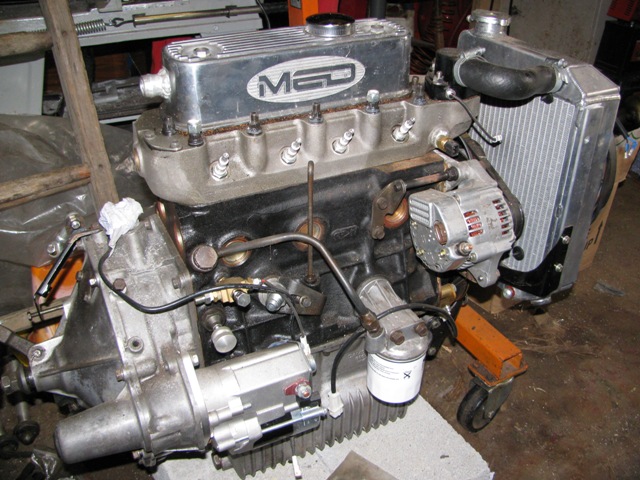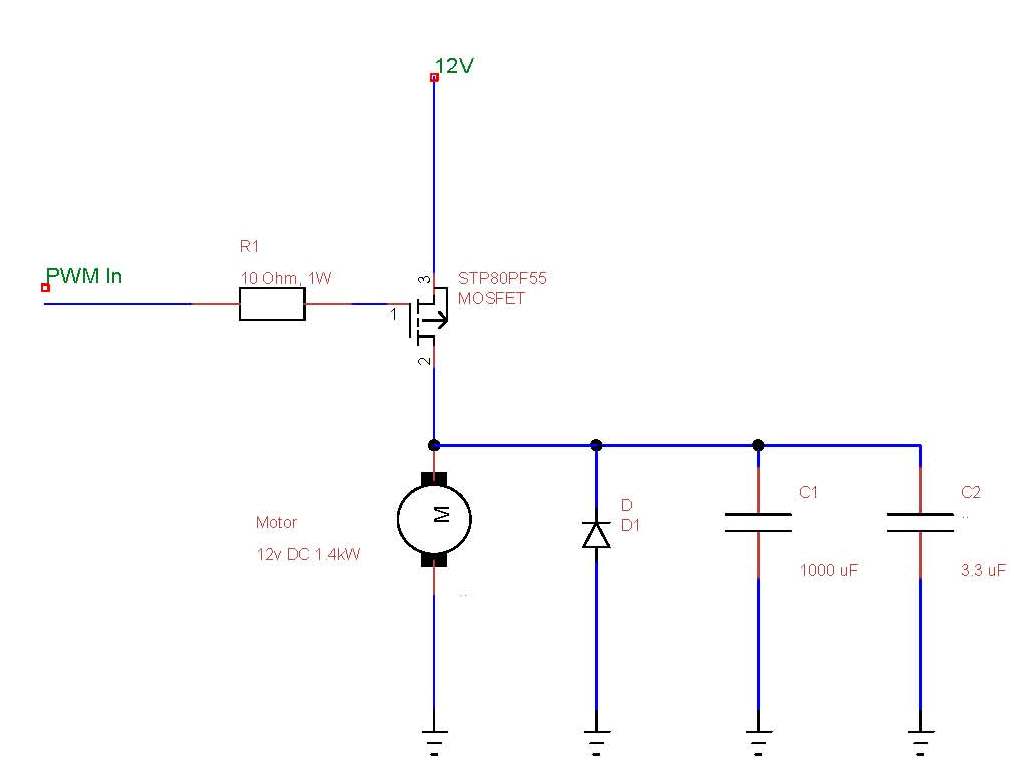| Page: |
| Home > A-Series EFI / Injection > DC Motor Control from ECU ??? | |||||||
|
8604 Posts Member #: 573 Formerly Axel Podland |
18th Nov, 2013 at 11:27:54am
Next job is to build up the MS3/3X and run a simple test to see how the motor responds under no load.
Saul Bellow - "A great deal of intelligence can be invested in ignorance when the need for illusion is deep."
|
||||||
 (2)[/url] by [url=https://www.flickr.com/photos/150672766@N03/]Rod Sugden[/url], on Fli) 5988 Posts Member #: 2024 Formally Retired Rural Suffolk |
18th Nov, 2013 at 01:59:57pm
Just my initial thoughts.
Schrödinger's cat - so which one am I ??? |
||||||
|
8604 Posts Member #: 573 Formerly Axel Podland |
18th Nov, 2013 at 02:17:50pm
Ha, just logged on to say that amps is going to be a problem to measure, even though I had not anticipated how big a problem.
Edited by Paul S on 18th Nov, 2013. Saul Bellow - "A great deal of intelligence can be invested in ignorance when the need for illusion is deep."
|
||||||
|
3594 Posts Member #: 655 Post Whore Northern Ireland |
19th Nov, 2013 at 12:01:16am
current monitoring...not that hard. There are hall sensors like these available that operate off 5v, and will let you log current via 0-5v on the ecu
9.85 @ 145mph
|
||||||
 (2)[/url] by [url=https://www.flickr.com/photos/150672766@N03/]Rod Sugden[/url], on Fli) 5988 Posts Member #: 2024 Formally Retired Rural Suffolk |
19th Nov, 2013 at 09:11:21am
Intriguing Stevie, I allways thought Hall (or any magnetic field derived measurement) was AC only.
Schrödinger's cat - so which one am I ??? |
||||||
|
8604 Posts Member #: 573 Formerly Axel Podland |
19th Nov, 2013 at 09:29:45am
With the purpose of the test to be to establish the pump performance characteristics, it would probably be easier to bypass the PWM speed control.
Saul Bellow - "A great deal of intelligence can be invested in ignorance when the need for illusion is deep."
|
||||||
 (2)[/url] by [url=https://www.flickr.com/photos/150672766@N03/]Rod Sugden[/url], on Fli) 5988 Posts Member #: 2024 Formally Retired Rural Suffolk |
19th Nov, 2013 at 10:00:29am
Sounds like a plan....
Schrödinger's cat - so which one am I ??? |
||||||
|
8604 Posts Member #: 573 Formerly Axel Podland |
19th Nov, 2013 at 03:17:05pm
One of these:
Saul Bellow - "A great deal of intelligence can be invested in ignorance when the need for illusion is deep."
|
||||||
|
3594 Posts Member #: 655 Post Whore Northern Ireland |
19th Nov, 2013 at 06:49:03pm
On 19th Nov, 2013 Rod S said:
Intriguing Stevie, I allways thought Hall (or any magnetic field derived measurement) was AC only. Still, never too old to learn. The problem with the ECU reading it to log it is that the sample rate of the data logging will be so much lower than the PWM frequency, the log, at any given PWM percentage, will contain a mixture of zero values and the actual current value. Not a problem to analyse the log manually after the event and use all the identical, non-zero, values to multiply by voltage and PWM percentage but it doesn't immediately lend itself to creating a "real time" power figure. Perhaps forcing the output of the current measuring device to be an average (something as simple as a capacitor perhaps ?) and then just recording voltage x average current and ignoring the PWM part of the equation. Or it "might" be possible to write a custom ini file to use the non-zero values only, although there's bound to be a few rogue values when the data is sampled just as PWM switches from on to off or vice versa. You'd still see an average current, or enough to be usable depending on how fast your logging rate is. With a scope logging at a very high rate, you see lots of information It's basically a more fixed version of these ( cheaper alternatives available on egay ) that you'd use with a meter or oscilloscope. Thee run off a 9v battery, and output 0-5v based on current. http://accessories.picotech.com/current-clamps.html 9.85 @ 145mph
|
||||||
|
8604 Posts Member #: 573 Formerly Axel Podland |
20th Nov, 2013 at 10:09:54am
I have a 2000A Heme Power Clamp. I used to use it professionally until I nearly killed myself trying to use it in a live 200kW starter :(
Saul Bellow - "A great deal of intelligence can be invested in ignorance when the need for illusion is deep."
|
||||||
|
3594 Posts Member #: 655 Post Whore Northern Ireland |
20th Nov, 2013 at 11:03:42am
If you wanted a current clamp for workshop use and for temporary logging with the ecu, this is what I bought to use with the USB scope
9.85 @ 145mph
|
||||||
 (2)[/url] by [url=https://www.flickr.com/photos/150672766@N03/]Rod Sugden[/url], on Fli) 5988 Posts Member #: 2024 Formally Retired Rural Suffolk |
20th Nov, 2013 at 02:04:25pm
On 19th Nov, 2013 Paul S said:
Totally confused by ratings for resistors :( Before the long boring bit, if you don't want to make your own resistor(s) - it's really quite easy, as I'll say later - I think you would be better of using your PWM drive and any of the current measuring devices suggested - you need to test it anyway ??? So for resistor(s)... OK, a bit simplistic, but let's say the motor maximum rating is 1KW. From P=VI That's 83A at 12V So you want to run at 1/2 speed and simplistically say by dropping the motor voltage to 6V using a resistor, firstly the resistor should be the same value as the motor windings (which it's allways difficult to be precise about because of inductance and back EMF in DC motors) in which case the total circuit resistance doubles so the Amps halve (42A). Because the voltage across the motor has also halved, this means the motor is now at 1/4 power. If motor resistance was as simple as V=IR the resistance of a 1KW, 12V motor would be 0.15Ohms so you would need a 0.15Ohm resistor in series to achieve this. The resistor rating would need to be 250W because you have split the 12V into two 6V parts of the potential divider at half the overall current (so P=6x42 or you can use P=I^2R so 42^2x0.15, both give the same, subject to rounding errors). But if you don't want the motor to run so slow, let's say you want 9V across the motor, the resistor would need to go down to 0.05hms - simple potential divider - 9/12 = (0.2/(0.15+0.05)) Total resistance is now 0.2Ohm so total current (I=V/R) is 60A And by I^2R, the resistor now has to disipate 180W and the motor 540W That's why PWM is the only sensible way to drive a DC motor to avoid wasted heat. But if you want to try resistor(s) you are looking at a ball park figure of 0.05Ohms to 0.25Ohms The problem is compounded though with a variable resistor like the one you have linked (ignoring the fact it's to high a value for the moment). Although it is 600W, that type of resistor will only be able to disipate 600w when the whole of the length is in use, ie, it's maximum resistance. Once you move the slider to half way down it will only be able to dissipate 300W without the half that is in use overheating. Use even less and it gets worse. So although the drop in power of the resistor goes down slightly as per my example above, it isn't linear like the slider type variable resistors. Better to use individual resistors of different values to test at individual speed/power if you want to use resistors. But you are not likely to find such low values (Ohms) at such high powers off the shelf. What I did in my model engineering days (before I went PWM) was make my own. I'll describe how later if you want to do it (maybe even find one of my old ones and photo it) but if I say now, someone will take the piss... Schrödinger's cat - so which one am I ??? |
||||||
|
8604 Posts Member #: 573 Formerly Axel Podland |
21st Nov, 2013 at 02:10:37pm
Ummm, we'll see.
Saul Bellow - "A great deal of intelligence can be invested in ignorance when the need for illusion is deep."
|
||||||
|
8604 Posts Member #: 573 Formerly Axel Podland |
22nd Nov, 2013 at 04:04:45pm
Well that was a great success........... not. The smell of electrical burning has filled the house.
Saul Bellow - "A great deal of intelligence can be invested in ignorance when the need for illusion is deep."
|
||||||
|
3594 Posts Member #: 655 Post Whore Northern Ireland |
22nd Nov, 2013 at 10:09:28pm
no fuse ?
9.85 @ 145mph
|
||||||
 (2)[/url] by [url=https://www.flickr.com/photos/150672766@N03/]Rod Sugden[/url], on Fli) 5988 Posts Member #: 2024 Formally Retired Rural Suffolk |
23rd Nov, 2013 at 02:41:31pm
That does seem a bit strange.
Schrödinger's cat - so which one am I ??? |
||||||
 12307 Posts Member #: 565 Carlos Fandango Burnham-on-Crouch, Essex |
23rd Nov, 2013 at 03:37:05pm
On 28th Aug, 2011 Kean said:
At the risk of being sigged... Joe, do you have a photo of your tool? http://www.turbominis.co.uk/forums/index.p...9064&lastpost=1 https://joe1977.imgbb.com/ |
||||||
|
8604 Posts Member #: 573 Formerly Axel Podland |
23rd Nov, 2013 at 03:54:03pm
Well, the motor nearly jumped off the bench when I applied 12v. Too much torque and a huge amp draw to go with it.
Saul Bellow - "A great deal of intelligence can be invested in ignorance when the need for illusion is deep."
|
||||||
 12307 Posts Member #: 565 Carlos Fandango Burnham-on-Crouch, Essex |
23rd Nov, 2013 at 04:50:50pm
On 28th Aug, 2011 Kean said:
At the risk of being sigged... Joe, do you have a photo of your tool? http://www.turbominis.co.uk/forums/index.p...9064&lastpost=1 https://joe1977.imgbb.com/ |
||||||
 12307 Posts Member #: 565 Carlos Fandango Burnham-on-Crouch, Essex |
23rd Nov, 2013 at 04:52:22pm
essentially you need a pullup on the gate to turn the Fet off otherwise it'll shit itself. On 28th Aug, 2011 Kean said:
At the risk of being sigged... Joe, do you have a photo of your tool? http://www.turbominis.co.uk/forums/index.p...9064&lastpost=1 https://joe1977.imgbb.com/ |
||||||
|
8604 Posts Member #: 573 Formerly Axel Podland |
23rd Nov, 2013 at 05:00:22pm
Thanks Joe.
Saul Bellow - "A great deal of intelligence can be invested in ignorance when the need for illusion is deep."
|
||||||
 12307 Posts Member #: 565 Carlos Fandango Burnham-on-Crouch, Essex |
23rd Nov, 2013 at 05:36:55pm
just stick another NPN transistor stage on the front end to invert it? On 28th Aug, 2011 Kean said:
At the risk of being sigged... Joe, do you have a photo of your tool? http://www.turbominis.co.uk/forums/index.p...9064&lastpost=1 https://joe1977.imgbb.com/ |
||||||
|
8604 Posts Member #: 573 Formerly Axel Podland |
23rd Nov, 2013 at 05:52:11pm
Let's be clear. this is the circuit that I'm currently using:
Saul Bellow - "A great deal of intelligence can be invested in ignorance when the need for illusion is deep."
|
||||||
 12307 Posts Member #: 565 Carlos Fandango Burnham-on-Crouch, Essex |
23rd Nov, 2013 at 06:08:49pm
Ah ok,
On 28th Aug, 2011 Kean said:
At the risk of being sigged... Joe, do you have a photo of your tool? http://www.turbominis.co.uk/forums/index.p...9064&lastpost=1 https://joe1977.imgbb.com/ |
||||||
|
8604 Posts Member #: 573 Formerly Axel Podland |
24th Nov, 2013 at 11:18:42am
I agree with you Joe. I can't see how it would switch without some volts on the gate.
Edited by Paul S on 24th Nov, 2013. Saul Bellow - "A great deal of intelligence can be invested in ignorance when the need for illusion is deep."
|
||||||
| Home > A-Series EFI / Injection > DC Motor Control from ECU ??? | |||||||
|
|||||||
| Page: |





